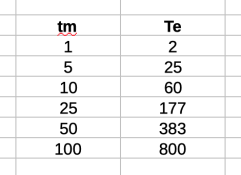Lee L
Member
- Joined
- Nov 17, 2004
- Messages
- 3,282
- Format
- Multi Format
Well, here's a fit to Maris' findings for Fomapan 200 with my favorite formula for reciprocity, the third formula mentioned in my earlier post #19 to this thread:
corrected time = a * metered time^b + metered time
where
a=1.0728074
b=1.4366099
and the numbers compared:
metered.....Maris.....calculated
1..............1.5............2.1
2.................4............4.9
3.................7............8.2
4...............12..........11.9
6...............18..........20.1
8...............28..........29.3
10.............40..........39.3
14.............48..........61.5
20...........100..........99.4
30...........175.........172.1
50...........350.........346.0
100.........900.........901.2
Pretty decent fit.
Lee
corrected time = a * metered time^b + metered time
where
a=1.0728074
b=1.4366099
and the numbers compared:
metered.....Maris.....calculated
1..............1.5............2.1
2.................4............4.9
3.................7............8.2
4...............12..........11.9
6...............18..........20.1
8...............28..........29.3
10.............40..........39.3
14.............48..........61.5
20...........100..........99.4
30...........175.........172.1
50...........350.........346.0
100.........900.........901.2
Pretty decent fit.
Lee













